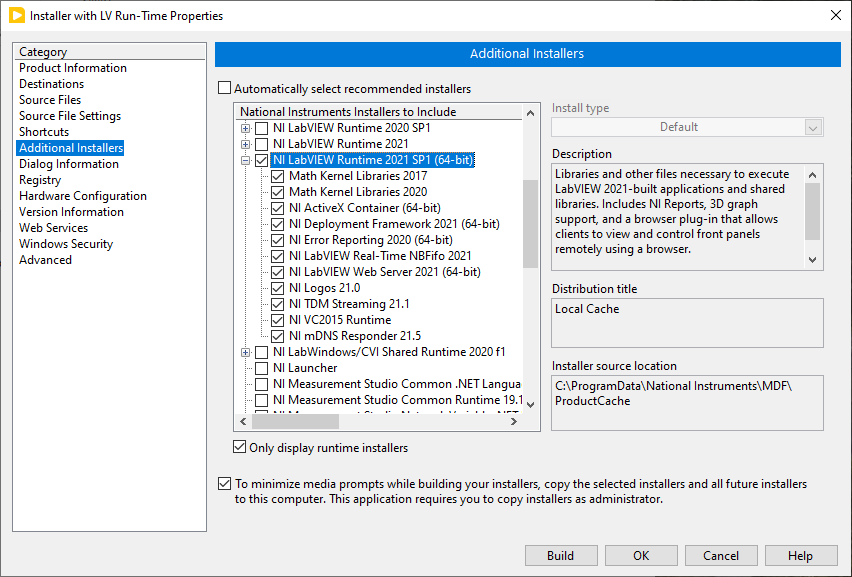-
Posts
101 -
Joined
-
Last visited
-
Days Won
1
AutoMeasure last won the day on April 23 2021
AutoMeasure had the most liked content!
Profile Information
-
Gender
Male
-
Location
Boston, Mass.
Contact Methods
- Personal Website
- Company Website
- LinkedIn Profile
LabVIEW Information
-
Version
LabVIEW 2022
-
Since
1991
Recent Profile Visitors
7,521 profile views
AutoMeasure's Achievements
-

Preventing Windows going to Lock screen
AutoMeasure replied to AutoMeasure's topic in User Interface
I tried it, that Request Display function works in my test program. Looks like I just need to call it once and then keep the handle open. Thanks very much! -Joe -
Hi folks - Do any of you know of a way to prevent Windows from going to lock screen during a long test run, by sending a command or doing some action periodically inside the Labview program? Assuming that the lock screen timeout setting is inaccessible due to access restriction. Telling the test operator to jiggle the mouse every couple of minutes is not always an option, ha ha. Thanks, -Joe
-
Hello Martin, thanks very much! Back in 2008 I ceased the practice of including LabVIEW Run-Time (and other drivers) in my app installer, and have been installing those separately. I forgot about the run-time components selection, thanks for pointing that out, I'll try that. For the app today, I don't need any of the checked subcomponents below. Thanks for the link to your lvserial driver package. Brings back pre-VISA memories! -Joe
-
Hi Sergey - Thank you very much for the really helpful reply! That is a lot of good advice. I have some work to do. We do disable much Windows functionality using their "policy" editor. I didn't think of the NI Services that are enabled to start up with the system. I just looked at those: I'll experiment with how much of this I can disable and still have LabVIEW Run-Time execute properly! Good point about NI-VISA. Upon review, yes I am only using it for RS232 communication for this particular project. Thanks for mentioning the FTDI driver. You made me remember also the .NET SerialPort class that already resides in Windows. I just now wired up a few functions to remind myself how that class works: Thanks again, -Joe
-
Hi folks - I have to install a Labview program on a product's embedded Windows 10 computer that at this time has zero NI software on it. The program needs to run immediately after computer boot-up, do its thing in under a minute, and then quit. I really need this program to start running as quickly as possible, and then after quitting leave nothing NI-related running. Do any of you have experience with this kind of situation? Are there any INI file settings or other configurations that will make LabVIEW Run-Time and NI-VISA run with minimal overhead and minimal sub-processes? For example, I don't want any NI processes to look for network connectivity at all nor attempt to "phone home". Also, after quitting I could halt specific processes and services that NI has left running. Thanks very much, -Joe
-
Hi colleagues - Have any of you tried the new 4-hour hands-on-the-software Certified TestStand Developer exam? I have to renew soon, and I see that NI has changed the renewal from a multiple-choice test to a "practical" exam. How challenging did you find it? Was 4 hours enough time to get everything done fully? Thanks very much, Joe
-
Hi folks - I like coding in Python and I like the numpy, scipy, and matplotlib libraries which are pretty complete and powerful. I'd like to figure out how to make those tools practical to use in my industry work as an alternative to Labview. As people have pointed out, making a high-performance, practical, good-looking UI for Python is too difficult and slow to develop. I tried using the REMI UI library at home for fun, and here are a couple of videos: Thermistors_Triple Python Program on a Raspberry Pi Tcontrol_PWM Python Program on a Raspberry Pi Have any of you tried using NI's G Web Development Software as a UI for Python? I know that NI charges for the package, but that could be OK for most industry work. Is it practical to implement and responsive to interaction? I see on NI's website that they recommend the SystemLink API for bidirectional data communication between the WebVI and the Python program. Have any of you tried calling NI-DAQmx from Python for continuous data acquisition? Does it work? For instrument control via USB and Ethernet, fortunately more instrument vendors are providing a Python-compatible library, so they're taking on the tough work. Thanks very much, Joe
-
I find TestStand to be a powerful, flexible platform and a very cleverly designed product, with features really well targeted to manufacturing test. But you have to take the time to master it and digest it in order to make it look and behave like you want, rather than be constrained by it. I tried Test Executive Toolkit in '97 and TestStand in '09 and discarded them right away in frustration. And then I was forced to get "over the hump" and master TestStand 2014 and 2016 while at Sonos, and now I like TestStand a lot. I don't use TestStand at my current company because I can't justify the cost, and we're not at the mass-production stage yet. I see that the current cost is $5,561 per Development seat, $2,814 per station for the Debug version, and $741 per station for Base Deployment (or $581 per station for qty. 5). Just plain too much, and the Base Deployment is just the engine, no sequence editor. Dear NI - Please price TestStand at $2,500 per Development seat, and $150 per computer for the Base Deployment. You don't need a distinct Debug version (it's the same as the Development version anyway). Also, please advertise your TestStand product! Tell everyone about the new affordable pricing! NI will benefit from the increased sales volume, and TestStand users will benefit from having a larger community of users to talk to and meet with. 🙂
-
You're right, I was thinking about the 16-Jun-2020 "National Instruments is now NI" event. 😏
-
Maybe it will be a two-day version of last year's virtual event, with more new fonts, colors, and NI employees forced to repeat "so inspiring". 🙃
-

Database Variant To Data function
AutoMeasure replied to AutoMeasure's topic in Database and File IO
Thanks hooovahh, I tried it in Labview 2018. Using the OpenG 'Array of Vdata to Vcluster_ogtk.vi' followed by the Variant To Data function works in my application, without using a malleable VI. Using the Database Variant To Data function alone can be wired successfully but generates a run-time error because my cluster includes some elements which are arrays. Thanks again for the hint. -Joe -

Database Variant To Data function
AutoMeasure replied to AutoMeasure's topic in Database and File IO
Hi hooovahh - I'm upgrading my operation from LV 2015 to LV 2018 and would like to redo your Array Of Variant To Cluster XNode as a malleable VI. Do you think that makes sense, and do you have any pointers that would improve my chances of success? :-) Thanks very much. -Joe -
Hey, guys, along the lines of this topic, I'm setting up to move my company forward in its Labview and Teststand versions. We're standardized on Labview 2015 SP1 f10 and Teststand 2016 f2, both 32-bit and both behaving well including running on Windows 10 64-bit. I'm thinking to move to Labview 2018 fn and Teststand 2017 fn. Should I do it now, and if so, should I try the 64-bit versions or is that still too risky? Also, although Teststand 2017 doesn't "officially" support Labview 2018 (http://www.ni.com/teststand/product_lifecycle/), it should work OK I'm guessing. Thanks. -Joe
-
Hi wire-heads, Have any of you started using LabVIEW NXG for real projects? How finished and stable do you find it? Also, do you find that it can successfully co-exist with LabVIEW 2015-2017 on the same development machine? Thanks very much. -Joe
-
Will be happily attending this BBQ with you guys! This will be my first NIWeek after almost making the trip every year. Joe







